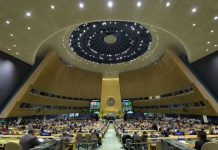Photo credit: DiasporaEngager (www.DiasporaEngager.com).
The March on Washington shows how artists, through solidarity and courageous love, helped bring the last one to an end.
By Ben Jealous —
Everywhere I go lately, people whisper the same question: are we sliding into another blacklist era? They point to what happened to Stephen Colbert. They point to what happened to Jimmy Kimmel. They point to other entertainers whose shows, jokes, or politics suddenly seemed to cost them work.
The fear is real. The memory of Hollywood’s first blacklist — when actors, writers, and directors were cast out of their professions under suspicion of disloyalty or mere association with the left — has never entirely faded. Now, in an age of hyper-partisan media and culture-war politics, it feels dangerously relevant again.
So what do we do about it?
Part of the answer will, as always in America, involve lawsuits. John Henry Faulk’s case against AWARE, Inc. in the 1950s proved that in a courtroom, lies can be punished and reputations can be restored. That victory helped to collapse the blacklist. But legal action, powerful as it can be, has never been the whole story.
The final, cultural death knell of the blacklist came not from a judge’s gavel, but from a march. On August 28, 1963, hundreds of thousands gathered at the Lincoln Memorial for the March on Washington for Jobs and Freedom. The headliners were Dr. Martin Luther King Jr. and A. Philip Randolph. But scattered throughout the crowd — and seated in solidarity near the stage — were some of the biggest stars in Hollywood: Sidney Poitier, Harry Belafonte, Lena Horne, Charlton Heston, Marlon Brando, Paul Newman, Joanne Woodward, James Garner, Burt Lancaster, Diahann Carroll, and more.
And I say this as someone who has studied and lived these movements: Virgil Frye was there too — and he helped organize them to get there. Frye, later remembered for his role in Easy Rider, was a working actor whose career was scarred by the blacklist, forcing him to shift into directing. Yet he still took enormous risks to support the movement. As a white man traveling to places like Gadsden, Alabama, he stood shoulder-to-shoulder with Black organizers at a time when “race traitors” were often punished more brutally by white Southern police — and in some cases, feared more by segregationists than the Black activists themselves. His courage was echoed decades later by his daughter, Soleil Moon Frye — Punky Brewster to a generation — who was arrested with me outside the White House protesting for voting rights. That’s what solidarity across generations looks like.
Here’s the crucial point: those artists protected each other. One lone actor might have been blackballed. But when Brando, Poitier, Belafonte, Heston, Newman, Woodward, Garner, Lancaster, Carroll, Horne, Frye, and others all stood together, the studios couldn’t punish them all. Safety came in numbers. Their collective presence made clear that the blacklist had lost its grip.
The very next day, King and Randolph headlined a socialist convention — the kind of gathering that, a decade earlier, could have landed every participant on a blacklist. Two days later, the actors who had risked standing in Washington went back to work. Their phones still rang. The studios still hired them. Their careers were intact.
In short: they had gone to Washington to demand freedom for Black Americans, and they returned home with a renewed freedom of their own. By breaking the unwritten rule of silence — and by showing courageous love in standing with those most under attack — they showed the industry and the country that the blacklist no longer held.
That’s the deeper lesson for us now. Lawsuits may help. Court battles may chip away at injustices. But the true end of a blacklist comes when artists, workers, and citizens together refuse to play by its rules. When they stand up publicly — in solidarity, in courageous love — they rob the blacklist of its power.
If we are, in fact, drifting toward a second blacklist era, the way out will look familiar. Not only in the courtroom, but in the streets. Not only in legal victories, but in the collective courage of people willing to risk their own status to defend the dignity of others. The artists who marched in 1963 helped to liberate Black people. And they also helped free themselves.
Ben Jealous is a professor of practice at the University of Pennsylvania, the former head of the NAACP, and the son of two civil rights workers — one Black and one white — who both took great risks in the movement.
Source of original article: The Institute of the Black World 21st Century (ibw21.org).
The content of this article does not necessarily reflect the views or opinion of Global Diaspora News (www.GlobalDiasporaNews.com).
To submit your press release: (https://www.GlobalDiasporaNews.com/pr).
To advertise on Global Diaspora News: (www.GlobalDiasporaNews.com/ads).
Sign up to Global Diaspora News newsletter (https://www.GlobalDiasporaNews.com/newsletter/) to start receiving updates and opportunities directly in your email inbox for free.




























